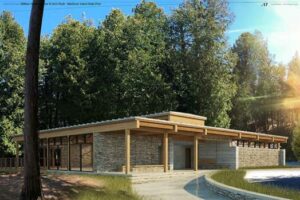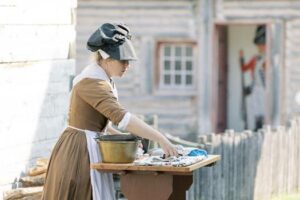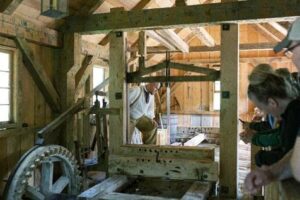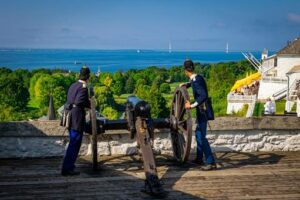With opening days fast approaching, the Mackinac State Historic Parks crew is hard at work constructing new buildings, creating new exhibits, fine-tuning programs, preparing the historic sites, and finalizing special events to share the rich historic and natural treasures of Mackinac Island and Mackinaw City.
“We are excited to welcome visitors to experience our parks and numerous attractions,” said Steve Brisson, Mackinac State Historic Parks Director. “We are hard at work and busy preparing to have everything ready for our spring openings.”
Starting on Mackinac Island, the Milliken Nature Center has been designed to accent the natural beauty of Arch Rock – not dominate it. The exhibit inside, Arch Rock: Unsurpassed in Nature’s Beauty, will celebrate what was known as the “Jewel of the Mackinac National Park” and is still today known as a “Star Attraction of Mackinac Island State Park.” It will feature dozens of stunning historic images of Arch Rock as well as a timeline on how the arch was formed. In addition, the center will highlight geology on Mackinac Island as a whole, from the formation of the island itself to how features such as Sugarloaf Rock and Skull Cave came to be. A highlight of the center will be an interactive 3D map of the island. Finally, new modern restrooms will also be located at the site.

“The Milliken Nature Center will be a welcome and fitting addition to Mackinac Island State Park,” Brisson said. “We look forward to welcoming guests this spring. We’re honored it will feature the name of Governor Milliken, who loved this island, and are appreciative of the support of Governor Whitmer, the state legislature, and Mackinac Associates to see this project come to fruition.”
The Milliken Nature Center and restrooms are slated to open in early M
Moving to Mackinaw City, work is underway on the first reconstruction at Colonial Michilimackinac since 2013. Located on the east end of the Southwest Rowhouse, the building will host a new exhibit, combining archaeological and archival research to help present community life at Michilimackinac in the 1700s: Slavery at the Straits. Throughout the 17th and 18th centuries, slavery was integral part of the community at Michilimackinac, as well as the rest of Michigan. Enslaved Black and Native American men and women worked in all levels of society, doing everything from domestic work to skilled labor. Already a hub of the Great Lakes fur trade, Michilimackinac also served as the center of the regional trade in enslaved workers as French and British colonists exploited preexisting systems of Native American enslavement to feed a growing demand for enslaved labor.
“This new exhibit explores the lives of these enslaved individuals and how their experiences fit in with the larger story of Michilimackinac, allowing us to present a more complete vision of the site in the 18th century,” Brisson said.
Staying at Michilimackinac, the year 1781 will be explored, when local and global forces uprooted the entire community as soldiers and civilians relocated to Mackinac Island. After six decades as a thriving diplomatic and economic hub, Michilimackinac came to an end in 1781. A special daily program will go into detail on the end of Michilimackinac.
 Other programs throughout the day explore the rich history of the site and showcase how it was more than a military outpost. Get an up-close look at the merchandise that passed through Michilimackinac during the height of the fur trade; learn about the different architectural styles found at the fort; explore dining culture at a Merchant’s House; explore the 5,500 square feet of gardens during an engaging tour; have tea at a British Trader’s home and dive into the complexities of British society; find out what civilians and soldiers were up to; and, of course, feel the power of Michilimackinac’s weapons with musket and artillery firings.
Other programs throughout the day explore the rich history of the site and showcase how it was more than a military outpost. Get an up-close look at the merchandise that passed through Michilimackinac during the height of the fur trade; learn about the different architectural styles found at the fort; explore dining culture at a Merchant’s House; explore the 5,500 square feet of gardens during an engaging tour; have tea at a British Trader’s home and dive into the complexities of British society; find out what civilians and soldiers were up to; and, of course, feel the power of Michilimackinac’s weapons with musket and artillery firings.
“The gorgeous setting and beautiful reconstruction of the 18th-century fur trading village and fort overlooking the Straits of Mackinac are worth a visit for everyone that comes to Mackinaw City,” said LeeAnn Ewer, Curator of Interpretation. “Here you will be able to explore and learn about what the last year of Michilimackinac was like for the soldiers and civilians that disassembled the community and moved to Mackinac Island. Our newest tour will highlight the move to the island, as well as the historic architecture that would have housed the community daily from Michigan weather as well as the occasional war.”
The Mackinac State Historic Parks’ archaeology program will enter its 66th season in 2024. Work will continue in House E of the Southeast Rowhouse at Colonial Michilimackinac. Archaeologists will be out daily (weather permitting) during the summer months. Guests will have the opportunity to see the most recent finds at Colonial Michilimackinac with a “Recent Excavations” display inside the Colonial Michilimackinac Visitor’s Center.
Want to get closer than ever to the action at Colonial Michilimackinac? Guests have two opportunities to fire black powder weapons: an opening cannon blast, at 9:30 a.m., or they can fire the full complement of weapons at Guns Across the Straits. Reservations for either program can be made by calling (231) 436-4100. More information can be found here.
Special events at Colonial Michilimackinac include exhilarating “Fire at Night” programs, deep dives into Michilimackinac’s maritime history, a celebration of the King’s Birth-day on June 4, a look at Askin’s Men and Women at Michilimackinac in August, a moonlit Michilimackinac evening, the ever-popular Fort Fright, and A Colonial Christmas. More information can be found at mackinacparks.com/events.
Colonial Michilimackinac opens for the 2024 season May 8.
Old Mackinac Point Lighthouse, across the park from Colonial Michilimackinac, will see the continued restoration of the site to its 1910 appearance. This summer will see small details added to the site, including a privy, pump, and flagpole. A small sidewalk will be added to the privy and pump, and, along with the oil house that was added in 2023, new interpretive signs will be added. Old Mackinac Point Lighthouse opens for the season May 9.
Programs at Historic Mill Creek feature daily demonstrations of a reconstructed 18th century sawmill. With the smell of fresh sawdust in the air, the awesome power of the water never fails to impress as the mill springs to life, fed by the pond and ever-flowing currents of Mill Creek. Log hewing and pitsaw demonstrations will be relocated near the millpond, providing easier access and shaded seating for visitors of all ages. At the workshop historic farming programs highlight what life was like beyond the sawmill more than 200 years ago.
sawdust in the air, the awesome power of the water never fails to impress as the mill springs to life, fed by the pond and ever-flowing currents of Mill Creek. Log hewing and pitsaw demonstrations will be relocated near the millpond, providing easier access and shaded seating for visitors of all ages. At the workshop historic farming programs highlight what life was like beyond the sawmill more than 200 years ago.
During the summer months, special themed weeks will dig deeper into the story of Historic Mill Creek. From June 23-29, enjoy “Wildlife Week at Historic Mill Creek,” featuring the amazing animals of the North Woods. From July 21-27, enjoy “Hay Cutters & Summer Pasture,” as programs explore historic hay making at the Straits of Mackinac. Finally, August 18-24 will feature “Lost Rocks & Mackinac Millstones,” where guests will earn about the grist mill at Mill Creek, and how the Mill Creek millstones were hewn from “lost rocks” deposited by glaciers thousands of years ago.
On the wild side, Historic Mill Creek’s 3.5 miles of interpreted hiking trails are always open and available to explore. During the summer months, join a trained naturalist at various times of the day for a guided walk along the trails, looking for blooming wildflowers, fruiting fungi, and singing birds among the trees, as well as for any wildlife along the banks of Mill Creek.
“We’re excited to enter a year of transition at Historic Mill Creek,” shared Park Naturalist Kyle Bagnall. “This year, special themed weeks will highlight aspects of the site’s amazing history. Guests can join a naturalist for short, guided trail walks. We’ll bask in the summer sun as we listen for the swish of the scythe and tales of historic hay cutters. Finally, we’ll join a hunt for “lost rocks” which traveled hundreds of miles thousands of years ago before landing at Mackinac.”
Historic Mill Creek opens for the regular 2024 season May 10.
 Moving back to Mackinac Island, Fort Mackinac opens for the 2024 season on May 3. Guests can discover two new programs: “Medicine at Mackinac,” where interpreters will provide the history of Army Surgeons and how the Army began changing military medicine in the 1880s. In addition, a Guard Mount Program will show guests how soldiers would conduct this complex military ceremony. Other programs at the fort include a walking tour about the changing face of Fort Mackinac, an exploration of the people who lived and worked at the fort, how the Army of the 1880s conducted itself, a look at Mackinac’s time as a national park, a program showcasing the equipment a soldier was issued, and an exploration of what happened at Fort Mackinac after the sun set. In addition, the classic rifle and cannon firing demonstrations will both feature refreshed presentations.
Moving back to Mackinac Island, Fort Mackinac opens for the 2024 season on May 3. Guests can discover two new programs: “Medicine at Mackinac,” where interpreters will provide the history of Army Surgeons and how the Army began changing military medicine in the 1880s. In addition, a Guard Mount Program will show guests how soldiers would conduct this complex military ceremony. Other programs at the fort include a walking tour about the changing face of Fort Mackinac, an exploration of the people who lived and worked at the fort, how the Army of the 1880s conducted itself, a look at Mackinac’s time as a national park, a program showcasing the equipment a soldier was issued, and an exploration of what happened at Fort Mackinac after the sun set. In addition, the classic rifle and cannon firing demonstrations will both feature refreshed presentations.
“2024 will be an exciting year because we are continuing to expand the programs we offer as well as adding greater depth to our classic programs, creating a fun and educational experience for anyone coming to Mackinac Island,” explained Jack Swartzinski, Mackinac State Historic Parks’ Interpretation Coordinator.
The Tea Room at Fort Mackinac, operated by Grand Hotel, will feature new menu items for the 2024 season, and, as always, will feature one of the most stunning views in Michigan. Perhaps the way to make a Fort Mackinac visit most memorable is firing the opening cannon salute, which is available to one guest daily. More information can be found here.
The Richard & Jane Manoogian Mackinac Art Museum, located in Marquette Park in front of Fort Mackinac, will feature Mackinac Rocks!, a juried exhibition in the second floor changing gallery. From looking in wonder at the natural curiosity that is Arch Rock to skipping rocks at Windermere Point, to maybe enjoying some ‘rock’ at a local establishment or the fact that Mackinac Island is itself a large rock, it is safe to say that Mackinac Rocks!
An art attendant will lead guided tours of the galleries, including a look at Native American art on Mackinac, and the works of photographer William Gardiner. In addition, the attendant will lead two “Kids’ Time” crafts in the lower-level art studio. Additionally, nine artists-in-residence will stay on Mackinac Island throughout the summer. Each artist will host a special, free workshop on the second Wednesday of their residency.
Elsewhere on Mackinac Island, the Biddle House, featuring the Mackinac Island Native American Museum, shares the continuing store of the Anishnaabek on Mackinac Island, with daily interpretive programs and engaging exhibits. The Benjamin Blacksmith Shop, located next door to the Biddle House, is a working blacksmith shop that dives into the 1950s and the changing culture of workers on Mackinac Island. The American Fur Co. Store & Dr. Beaumont Museum and McGulpin House have both received new exhibits in the past two years. Admission to all of these sites is included with a Fort Mackinac or Historic Downtown Mackinac ticket.
The Biddle House, featuring the Mackinac Island Native American Museum, Benjamin Blacksmith Shop, and The Richard & Jane Manoogian Mackinac Art Museum open for the 2024 season on May 10. The McGulpin House and American Fur Co. Store & Dr. Beaumont Museum open June 1.
Special events at Fort Mackinac and Mackinac Island include the Fort2Fort Five Mile Challenge May 11; the annual Vintage Base Ball game July 27; special activities for July 4; special history evening programs including a guided tour of Historic Downtown Mackinac as it would have looked in the 1830s and a tour highlighting the creation of the village of Mackinac Island; special nature and birdwatching tours; night sky programs at Fort Holmes and Arch Rock; bike tours looking at Mackinac’s forgotten features and the War of 1812; and much more. More information can be found at mackinacparks.com/events.
Every museum store will feature new items inspired by the site they represent. The Official Mackinac Island State Park Store, inside the Mackinac Island State Park Visitor’s Center, will continue to have new items inspired by the historic and natural elements of Mackinac Island.
Most major projects were funded, in part, by Mackinac Associates, friends preserving and sharing Mackinac’s history. Visit mackinacparks.com for a complete listing of updates and projects at Mackinac State Historic Parks, hours of operation, daily events, special events, and more.













